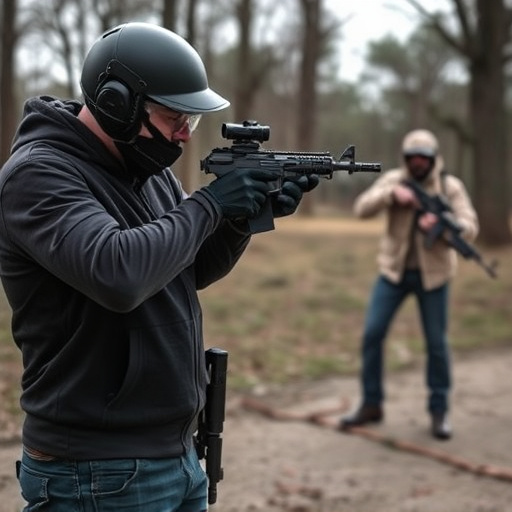Concealed pepper spray carrying techniques are crucial for personal safety in high-risk environments. Using specialized holsters, compact designs, and innovative attachments like keychains ensures swift access while maintaining discretion. Understanding local laws regarding permit requirements, spray type, and conditions is vital. Techniques include secure pockets or specialized containers that blend in with everyday items, regular practice under various clothing conditions, and muscle memory drills at ideal application distance. Training and safety enhance effectiveness during threats.
“In today’s uncertain times, understanding self-defense mechanisms like pepper spray is crucial. This article explores the power of concealed pepper spray carrying techniques as a personal safety strategy. We delve into the science behind pepper spray deterrents and their legal considerations, including permit requirements. Learn effective, discreet methods for carrying and deploying pepper spray, along with essential training tips to ensure safe and responsible use. Discover how these tactics can empower individuals to protect themselves in potential threats.”
- Understanding Pepper Spray as a Defense Mechanism
- Legal Considerations: Concealed Carry Permits
- Effective Techniques for Discreetly Carrying Pepper Spray
- Training and Safety Tips for Optimal Use
Understanding Pepper Spray as a Defense Mechanism
Pepper spray, a non-lethal self-defense tool, has become a ubiquitous deterrent for individuals seeking protection in various situations. As an effective chemical agent, it temporarily incapacitates the target by causing intense irritation to the eyes and respiratory system. This disruption leads to temporary blindness, coughing, and difficulty breathing, providing the user with crucial time to escape or defuse the potential threat.
Carrying concealed pepper spray is a strategic approach for personal safety, especially in high-risk environments. Proficiency in discreet carrying techniques ensures that individuals can access their defense mechanism swiftly and effectively. Concealed carrying methods vary from specialized holsters designed to fit in pockets or small bags to innovative options like keychains and ring attachments, allowing users to have their spray readily available without drawing unnecessary attention.
Legal Considerations: Concealed Carry Permits
In many jurisdictions, the legal considerations surrounding concealed carry permits play a significant role in individuals’ ability to protect themselves with pepper spray. Obtaining a permit allows carriers to legally possess and use pepper spray for self-defense purposes. Different states and regions have varying regulations regarding what type of pepper spray is permissible, its concentration, and the specific conditions under which it can be carried. Understanding these legal parameters is crucial for ensuring compliance and maximizing the effectiveness of pepper spray as a deterrent.
Concealed pepper spray carrying techniques are designed to enable individuals to have quick access to their defense mechanism while adhering to legal guidelines. This involves learning proper holsters, pockets, or bags that securely hold the spray, ensuring it remains unobtrusive yet easily reachable in an emergency. By mastering these concealed carry techniques, individuals can protect themselves while navigating public spaces or potential threats without drawing unnecessary attention.
Effective Techniques for Discreetly Carrying Pepper Spray
Discreetly carrying pepper spray is a smart move for personal safety, especially in unfamiliar or potentially dangerous situations. One effective technique involves securing the spray in an easily accessible yet hidden pocket. Opt for a small, thin design that fits discreetly inside your jacket or vest pocket. Ensure it’s secure but still quickly retrievable when needed. Another strategy is to use specialized containers designed to look like everyday items, such as lip balms or pens. These concealed carriers allow you to transport pepper spray without drawing unnecessary attention.
Remember, the key is to choose a method that feels natural and allows for swift deployment. Regularly practice reaching for your pepper spray in various clothing configurations to ensure it’s second nature when faced with an emergency. By combining these concealed carrying techniques with awareness and self-defense training, you’ll be well-prepared to deter potential threats effectively while maintaining your safety.
Training and Safety Tips for Optimal Use
Training and safety are paramount when it comes to using concealed pepper spray as a defense mechanism. Understanding the proper carrying techniques and practicing deployment in safe environments can significantly enhance its effectiveness. Users should familiarize themselves with local laws regarding self-defense tools, ensuring they have the right to carry and use pepper spray legally.
When training, focus on learning the ideal distance for application, typically around 2–3 feet, and practice aiming at various body targets. Regular drills help maintain muscle memory, enabling swift reaction in high-stress situations. Always store the spray in a secure, easily accessible location, and consider wearing it during activities where you might encounter potential threats. Concealed carrying techniques, such as pocket or belt holsters, allow for quick retrieval while keeping the spray hidden from plain sight.
Pepper spray, as a personal defense mechanism, offers individuals a powerful tool to protect themselves in potentially dangerous situations. By understanding its effectiveness, legal frameworks surrounding concealed carry permits, and learning discreet carrying techniques, one can enhance their safety without compromising their freedom. Proper training and adherence to safety tips are paramount to ensure responsible use, making pepper spray a valuable asset for personal security. Mastering these concealed pepper spray carrying techniques empowers folks to navigate potentially threatening scenarios with newfound confidence and peace of mind.
